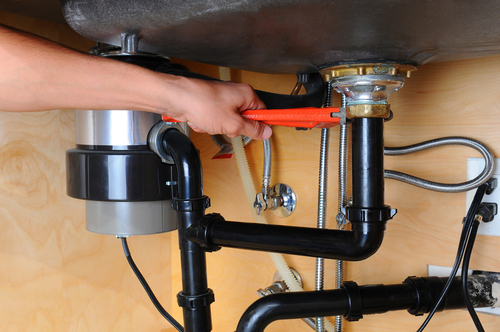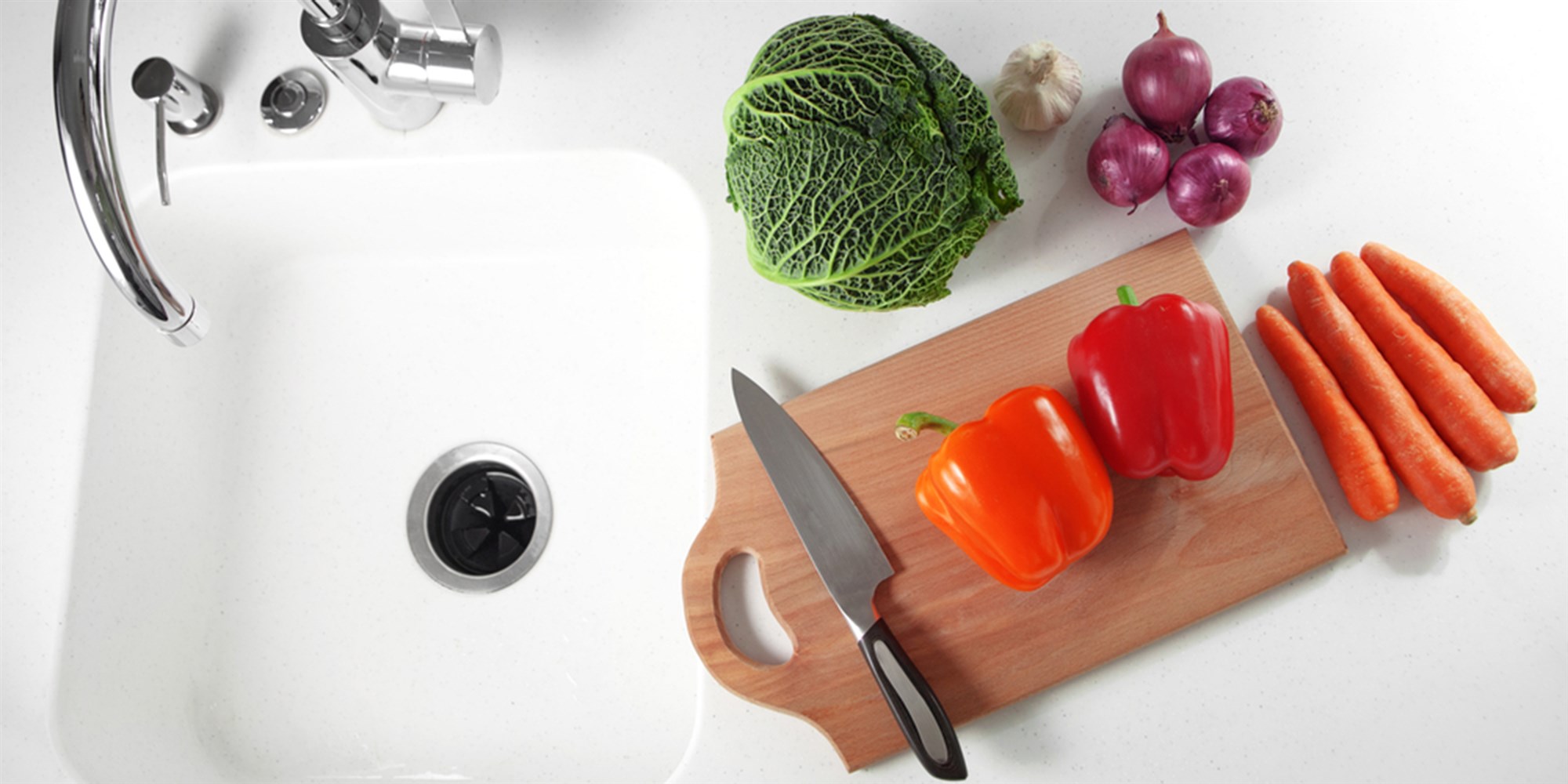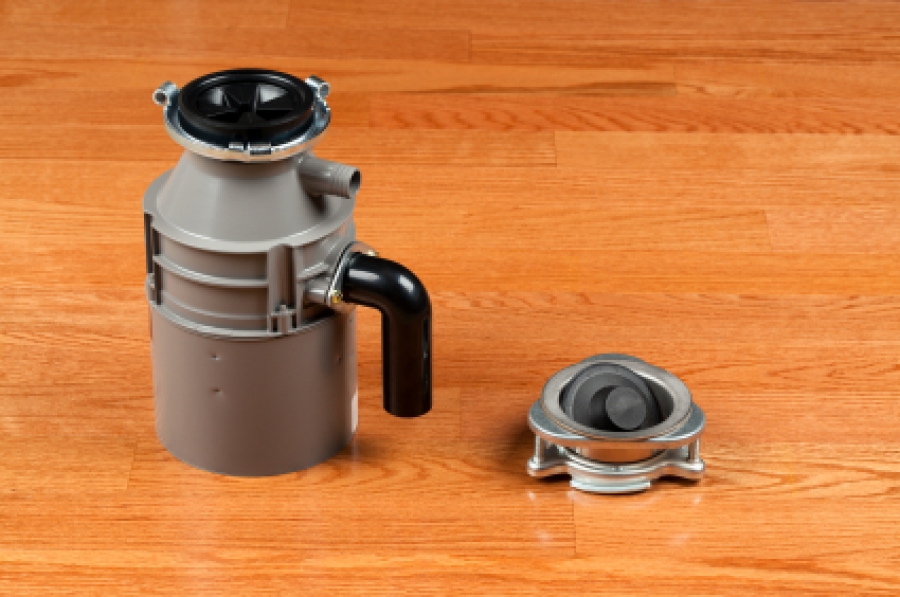How to Properly Use Your Garbage Disposal
First of all, while it may not seem too picky, your garbage disposal is made for biodegradable food only. Remember – when using your disposal, run water the entire time and for at least 20 seconds after you turn it off. Feed food slowly into the disposal and avoid dumping large amounts in at one time. Also, be sure to read the manual carefully and avoid things that are known to cause problems. If you find yourself with a clog, know that unclogging your garbage disposal doesn’t have to be draining.
How to Quickly Clean your Garbage Disposal
Having a wretched odor emanating from your sink is a surefire tip-off that your disposal is in dire need of a good cleaning. Don’t worry – there are plenty of thrifty ways you can resolve this issue. No need for special cleaners or chemicals, you can eliminate this problem with a variety of items you have laying around the house:
- Ice
- Ice and rock salt
- Baking soda and vinegar
- Citrus
- Borax
- Hot water and dish soap
- Dish soap and baking soda
- Boiling water
Know When It’s Repair Time
You gave it your best shot. You tried a variety of troubleshooting tips and still, the issue persists. Here are some telltale signs that it’s time to replace your garbage disposal:
- It clogs frequently even though you are taking good care of it
- You have to press the reset button a lot
- You can’t get rid of odors
- The blades have become dull
- You have a leak that can’t be easily fixed

Garbage Disposal Maintenance Tips
Garbage Disposal Daily Maintenance: Normal use is enough to help reduce accumulation as the garbage disposal is rinsed with soapy waste water after washing dishes.
Garbage Disposal Weekly Maintenance: On a weekly basis, the garbage disposal should be flushed with cold water. Fill the sink with clean cold water, pull the drain stop and allow the water to drain. The flushing action of the water leaving the sink through the drain will purge the drain line of any loose food waste.
Garbage Disposal Monthly Maintenance:
- Once a month empty a tray of ice cubes into the sink and turn on the garbage disposal to grind up the ice cubes. After the ice cubes are ground into a slushy mixture, rinse with a light stream of cold water. The ground ice will clog the drain line and water will backup into the sink, however after a few minutes the ice will melt away and the water will drain. Grinding ice helps to sharpen the shredding blades and remove the accumulation of food waste.
- If you have a removable drain baffle, remove it and clean the surface thoroughly with an old toothbrush, water, and detergent. Be sure to place the baffle back in it’s original location prior to operating the garbage disposal.
- Place a half cup of baking soda and one cup of vinegar in the grind chamber. Allow the mixture to foam and fizz while you boil a pot of water. Once the water has boiled, pour it down the drain. In lieu of baking soda and vinegar, you can also mix one gallon of water with one tablespoon of liquid chlorine bleach and slowly pour the mixture into the grind chamber. Allow it to sit for several minutes and then flush with cold water. These mixtures will sanitize the garbage disposal and remove any foul odor. If you would prefer to not experience the smell of bleach or vinegar emanating from the garbage disposal you can freshen the smell with citrus rinds. Lemon, lime, orange, and grapefruit rinds can be placed in the garbage disposal and ground-up to provide a fresh citrus scent.

Using a Garbage Disposal Correctly
Run cold water into the disposal as you turn it on.
Before you put any food in, turn the disposal on and let cold water from your sink flow into it. Keep this going for about 30 seconds to lubricate the blades inside of the disposal first.
- Always use cold water, not hot, when using your disposal to avoid melting any fat or grease on the food as you dispose of it.
- Keep the cold water running the entire time you use your disposal.
Avoid pouring grease, starch, or non-food items into your disposal.
Garbage disposals are made for food scraps only, meaning you should never pour anything inedible down them. Similarly, grease and fat can solidify inside of the disposal, causing it to clog or jam. And, starchy foods like corn husks, artichokes, and large amounts of vegetable peels can also cause clogs and jams. Foods to avoid putting down your disposal include:
- Oyster shells
- Clam shells
- Large amounts of egg shells
- Coffee grounds
- Expandable foods, like pasta
- Grease or fat
- Animal bones
- Corn husks
- Celery stalks
- Onion skins
Put bite-sized pieces of food down the disposal.
Garbage disposals are meant to handle food scraps, not full pieces of food. If you’re trying to dispose of anything larger than bite-sized, use a sharp knife to cut it up until all the pieces are about 1 in (2.5 cm) long.
- If you can’t cut up your food, consider composting it instead.
Drop the food down the disposal slowly.
Grab your food scraps and drop them into the disposal one handful at a time. Try to avoid overloading the disposal, as that can clog the blades and cause expensive repairs.
- Wait until you stop hearing a grinding noise in the disposal to drop another handful in.
Keep the disposal on for 30 seconds after you’re done putting food in.
Once you’ve put your last handful of food scraps in the disposal, wait for about 30 seconds to let the disposal finish working. If you don’t, you could leave food scraps in the blades, causing it to jam up the next time you use it.
Turn the disposal off, but let the water run for 15 more seconds.
Flip the switch to turn your disposal off, but keep using cold water from your sink for a little bit longer. This will help to flush out any remaining food that might be stuck in the disposal.
- Remember to always use cold water, even when the disposal is off, to avoid heating up any grease or fat stuck on the blades.

How to get rid of garbage disposal smells:
If you have a nasty smell coming from the disposal, there could be two causes: the drain and/or the rubber splash guard.
To clean the garbage disposal drain: Pour a ½ cup of baking soda into the drain, add a cup of hot white distilled vinegar (just heat it in the microwave), then watch it foam, says Reichert. “Let it sit for a few minutes, then pour a quart of boiling water down the disposal to flush everything down the drain. That will leave the chopping part of the disposal lovely and fresh!”
To clean the garbage disposal splash guard: Cleaning the rubber splash guard takes a bit more work, but it’s worth the effort. Slime and gunk that accumulate on the underside of the splash guard are a major source of odors and a breeding place for germs. To tackle the chore, you’ll need rubber gloves, an old toothbrush and hot, soapy water.
- For removable splash guards: While wearing gloves, remove the splash guard, then scrub the top and bottom of the rubber guard with a toothbrush and soapy water. Rinse and replace.
- For non-removable splash guards: While wearing gloves, first scrub the top side of the guard. Rinse. Then, lifting up the rubber guard a section at a time, scrub the underside of the splash guard until all slime and gunk are gone. Rinse.
Ice Cubes And Salt
Ice cubes with salt is used to remove tough sludge and debris that is stuck to the blades and other elements of the unit.
What you need: 2 cubes of ice cubes and 1 cup of rock salt/sea salt
Time: 7-8 minutes
Directions
- Turn on the garbage disposal and pour the ice cubes into it. Follow it with 1 cup of rock salt. You could improvise and use sea salt
- Run some cold water and let the the salt and ice get crushed by the blades
- The ice and salt will loosen the grime and dirt that is stuck to the impeller blades
- Continue to run the water for a few seconds after the noise from the machine stops
The combination of ice and salt not only cleans the unit but it also removes any unpleasant odor that stems up from the garbage disposal.